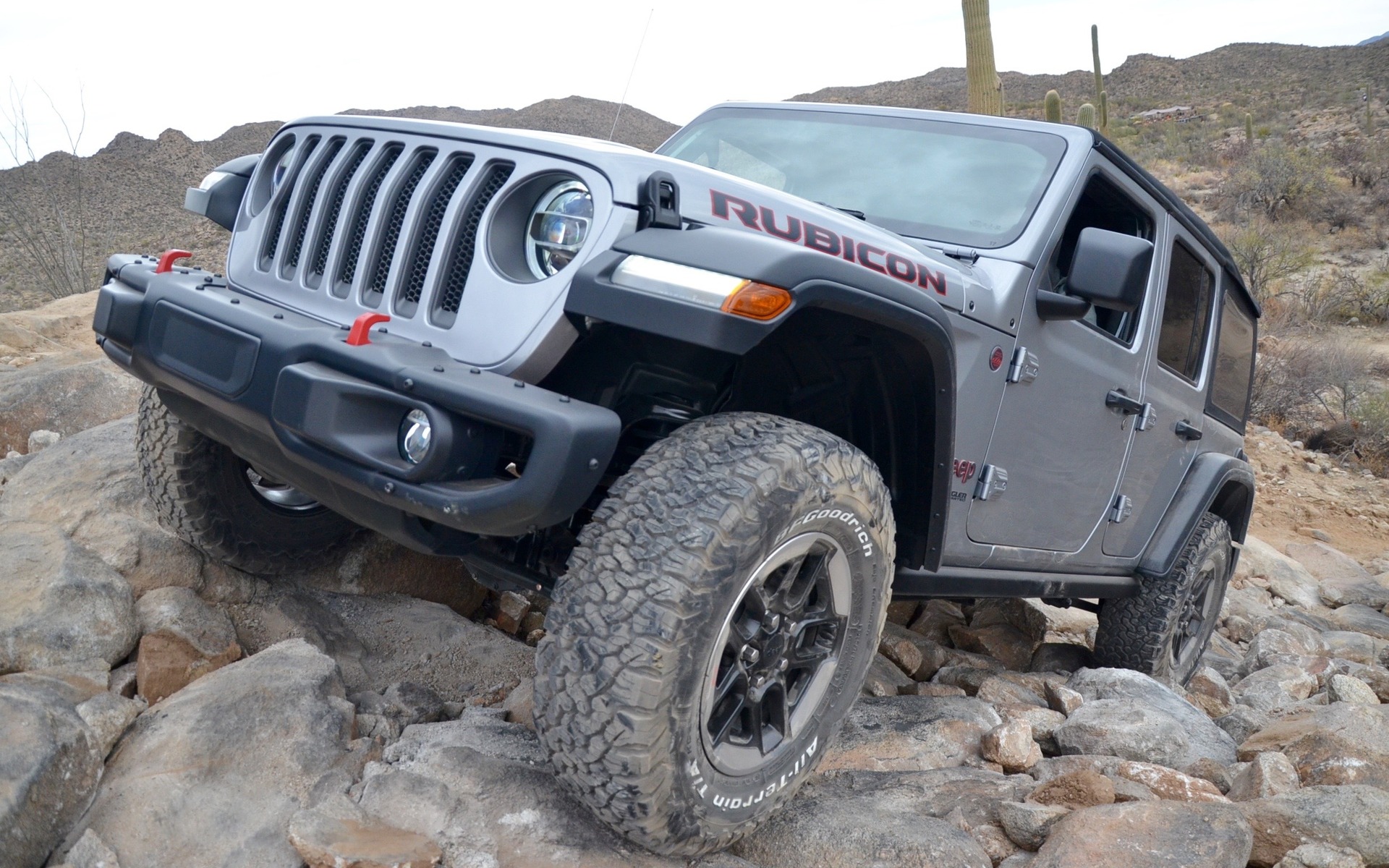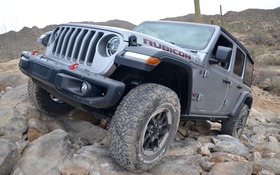2018 Jeep Wrangler: The New Generation of an Icon

| Strong points |
|
|---|---|
| Weak points |
|
TUCSON, Arizona – As the Wrangler Rubicon advanced at a snail's pace, all I could see through the windshield was the sky and the raised arms of my Jeep Jamboree guide. My task was to climb a rocky slope at Saguaro Ranch, not far from Tucson, Arizona. Here, the obstacles are rated 8.5 out of 10 by the pros from Jeep Jamboree. It’s nothing extreme, but hard work just the same.
I was tossed around while delicately controlling the accelerator as the Jeep crept slowly, but effortlessly up the rock. I placed each tire in the exact spot required to access the summit, blindly following the instructions of my guides. The body movement, the sometimes radical incline and the sound of the protective plates scraping against the rocks made me realize that the Wrangler is in a league of its own for its peerless off-road capabilities.
Equipped with BFGoodrich All-Terrain T/A KO2 tires, locking front and rear differentials and a front roll bar that can be disengaged electronically at the push of a button, the Wrangler Rubicon tackles obstacles better than any other Jeep. It’s impressive stuff.
After a 10-year career, the Jeep Wrangler JK is now making way for the new Wrangler JL. This newbie becomes the de facto spiritual heir of the Willys designed in the 1940s for the United States army. In an era in which new versions are released in rapid, often dizzying succession, the Jeep Wrangler is evolving at the speed of a glacier. Ten years for a new version is a long time.
The Wrangler is the most emblematic of all Jeeps. It defines the brand's purpose and captures the hearts of true off-road driving enthusiasts. This iconic status also means that Jeep’s creators and designers have no margin for error. The Wrangler is the cornerstone of the brand and is instantly recognizable.
For the new JL, the creators' challenge was twofold. From a technical standpoint, their first goal was to improve conventional driving dynamics while improving its off-road driving. Design-wise, the challenge was to respect the Wrangler legacy while making it more refined. They rose to this massive dual challenge beautifully.

Three Trim Levels
The new 2018 Jeep Wrangler remains true to its original concept with a body set on a ladder frame. However, this chassis has been made 45 kilograms lighter thanks to more widespread use of high-resistance steel and aluminum. What’s more, the vehicle has shed 90 kilograms compared with the JK.
This weight loss explains (in part) the slight improvement in fuel economy recorded in the versions featuring the 3.6-litre V6 Pentastar, which develops 285 horsepower and 260 lb.-ft. of torque.
A turbocharged, 2.0-litre four-cylinder engine producing 270 horsepower and 295 lb.-ft. of torque is also offered, but Jeep management expects 80% of buyers to choose the V6, since it’s the only engine that can be paired with the two new gearboxes (an eight-speed automatic or a six-speed manual). The four-cylinder engine comes only with the automatic.
A diesel engine will follow later, and Jeep plans to offer a hybrid Wrangler by 2020. For now, there are three versions (Sport, Sahara and Rubicon), two- or four-door configurations, several types of roofs and three four-wheel drive systems, including one all-wheel-drive setup. Basically, all potential buyers are advised to read the catalogue carefully. You will also be able to select equipment and accessories from the Mopar division. Hours of fun await.
On the Road
Before our off-roading challenge on the rock formations at Saguaro Ranch, we went for a drive that included the highway, secondary roads and dirt roads. Our ride was a Wrangler Sport powered by the 2.0-litre four-cylinder turbo and fitted with Bridgestone Desert Dueler tires. The handling and dynamics were noticeably improved compared to the previous version.
The vehicle now boasts an increased wheelbase and new electro-hydraulic steering that is sharper and more precise. Meanwhile, the braking met our expectations. Wind noise at highway speeds is less invasive since the windshield is more inclined, as is the peak of the grille. The new Wrangler is 10% more aerodynamic than the old one.
That being said, don’t expect the cabin to be as cushy as your living room. Softening the Wrangler’s angles is a little like filing a brick; it helps a bit, but there are limits to what is possible. The turbo engine delivers maximum torque earlier than the V6 (at 3000 rpm instead of 4800 rpm) by relying on the light hybrid system known as eTorque whose motor/electric generator helps acceleration while recovering kinetic energy when braking.
This four-cylinder engine is derived from the mill that powers the Alfa Romeo Giulia, but its cylinder heads are different. The Jeep engine is equipped with dual overhead cams rather than the MultiAir system found in the Alfa Romeo. In essence, the new Wrangler is more suited to everyday driving and compromises less on comfort for the sake of off-road capabilities.

Life Made Simpler
Purists will be pleased to know that you only need to unscrew four screws instead of 20 to drop the front windshield. It is also easier to take off and reinstall the aluminum doors. They’re eight kilograms lighter in front and seven kilograms lighter in back, and are equipped with a grip under the interior handle to facilitate handling. Same thing goes for the soft top, which has traded its zippers for sliding sections that are easier to use when you want to cover or uncover the Wrangler.
Big Transformation
In the makeover toward the new JL, the designers in charge of the interior got it right by creating a particularly nice design that evokes the legacy of previous versions. It includes the new fourth-generation Uconnect infotainment system, which is now faster and just as user-friendly as ever.
The new Wrangler also hits a bull’s eye for connectivity. Apple CarPlay and Android Auto come standard, just like several USB jacks and electric outlets for accessories. The designers even had the foresight to include four auxiliary buttons to connect aftermarket accessories. Two 2-door versions are offered, namely the Sport with a base price of $33,945 and the Rubicon at $46,345. There are three 4-door versions—the Sport ($41,745), Sahara ($45,745) and Rubicon ($48,745).
A Steep Hill to Climb
Hopefully, the new Wrangler will help the Jeep brand improve its long-term reliability record, which is still cruelly lacking. J.D. Power and Associates’ 2017 Vehicle Dependability Study, which measures vehicle reliability after three years of use, ranks Jeep 30th out of 31 brands. The same firm’s (2017 Initial Quality Study gave Jeep a score of 2 out of 5.
Basically, when it comes to quality and reliability, Jeep still has a steep hill to climb, no pun intended. Time will tell if the 2018 Jeep Wrangler is able to overcome this obstacle as easily as it climbed to the rock summit at Saguaro Ranch.











